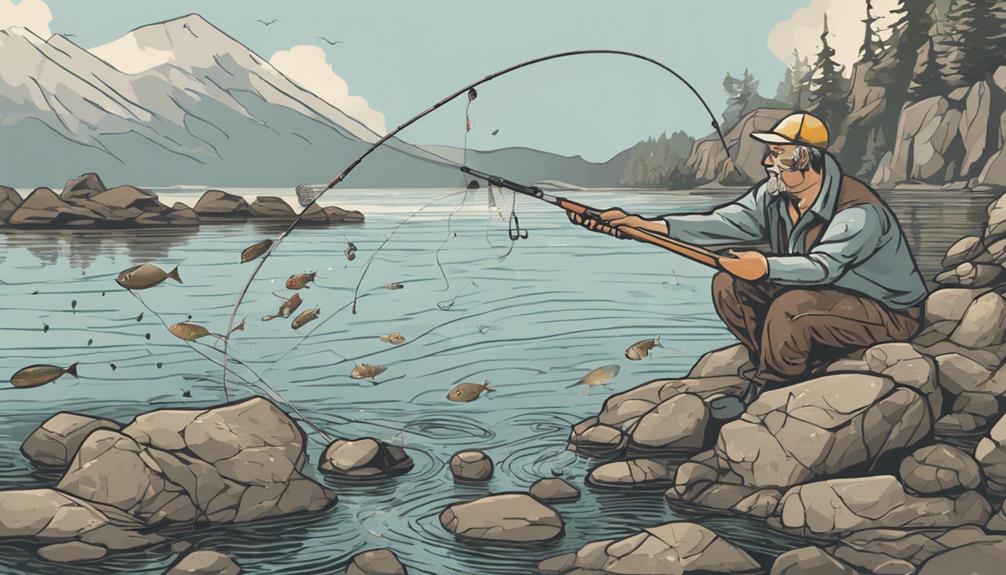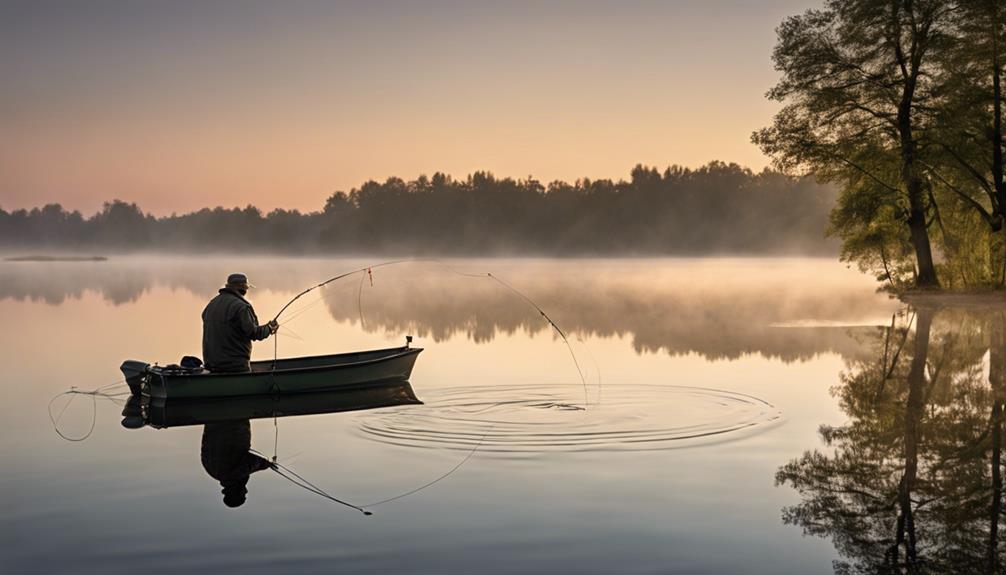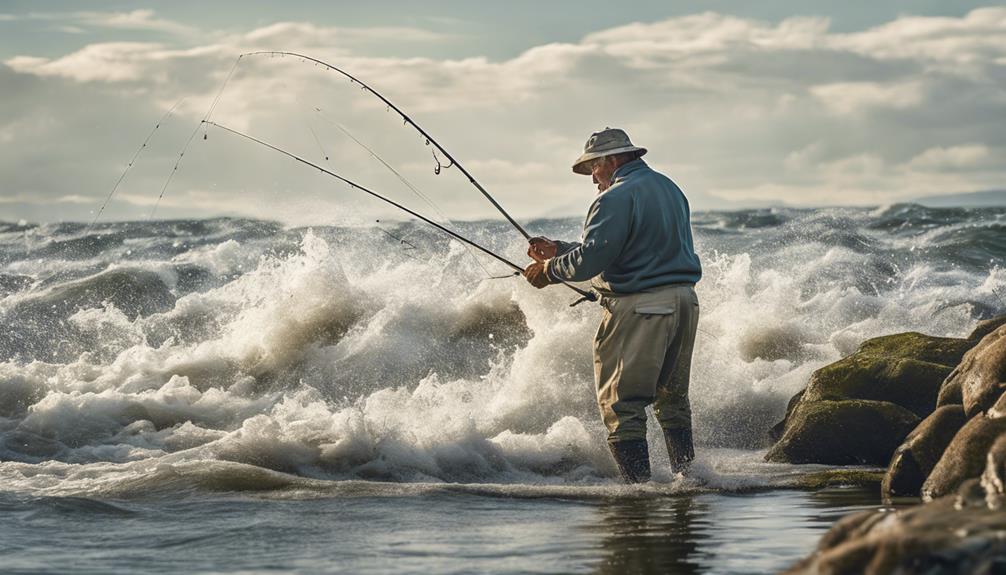When aiming to acquire ample flatfish, employing precise and practical tactics is pivotal.
From the selection of gear tailored to your target species to mastering the art of camouflaging within the aquatic realm, each strategy plays a crucial role in securing a successful catch.
However, there's one key element that ties these tactics together, a secret weapon that seasoned anglers swear by – a tactic that could be the game-changer in your flatfish fishing endeavors.
Gear Selection
When gearing up for flatfish fishing, make sure to choose a lightweight rod and a high-quality reel. The rod selection plays a crucial role in flatfish fishing. Opt for a rod that's sensitive enough to detect the subtle bites of flatfish but also has enough backbone to handle their strong initial runs. A medium-power rod around 6 to 7 feet in length is ideal for this type of fishing. Pair this with a high-quality reel that has a smooth drag system to handle the sudden bursts of energy exhibited by flatfish.
When it comes to line weight, lighter lines in the 6 to 12-pound range work best for flatfish fishing. Lighter lines are less visible in the water, increasing your chances of getting more bites. Additionally, using a fluorocarbon leader material can further increase your chances of success. Flatfish have keen eyesight, and a fluorocarbon leader material can be nearly invisible underwater, giving you an edge in enticing them to bite.
In terms of reel options, spinning reels are popular among flatfish anglers due to their ease of use and versatility. Look for a spinning reel with a smooth drag system and a gear ratio suited for handling the erratic movements of flatfish. By choosing the right rod, reel, line weight, and leader material, you set yourself up for a successful flatfish fishing adventure.
Bait and Lure Choices
What're the most effective bait and lure choices for successful flatfish fishing? When targeting flatfish, such as flounder or halibut, using the right bait and lures can significantly increase your chances of a successful catch. Here are some key considerations to keep in mind:
- Depth Control and Strike Triggers: Flatfish are often found near the ocean floor, so it's crucial to use baits and lures that can reach the desired depth quickly. Jigging spoons or weighted soft plastics are excellent choices for maintaining control over the depth of your presentation. Additionally, lures with built-in strike triggers like rattles or flashy components can help grab the attention of flatfish in murky waters.
- Scent Attraction and Color Selection: Flatfish have a keen sense of smell, making baits with strong scents highly effective. Using bait such as squid, shrimp, or fish strips can help attract flatfish from a distance. Moreover, color selection plays a vital role in enticing flatfish to strike. Opt for colors that mimic the natural prey of flatfish in the area you're fishing, such as sandy or mottled patterns for blending in with the seabed.
Perfecting the Drift
To enhance your flatfish fishing skills, mastering the art of perfecting the drift is essential. When drifting for flatfish, maintaining proper depth control is crucial. Adjust your boat speed to match the drift speed of the water, ensuring your bait stays at the desired depth where flatfish are most likely to be found. Wind direction plays a significant role in drift fishing. Position your boat so that the wind aids your drift rather than working against it. This will help you cover more ground effectively.
Moreover, keeping the right amount of tension on your line is key to detecting subtle bites from flatfish. Too much tension can hinder the natural movement of your bait, while too little can result in missed bites. Find the sweet spot where your line remains taut enough to feel the bites but still allows for natural movement.
Understanding Tides and Currents
Understanding tides and currents plays a crucial role in optimizing your flatfish fishing expedition. Tidal patterns and water movement greatly influence the behavior and location of flatfish. Here are three key points to help you master these elements:
- Study the Tidal Patterns: Familiarize yourself with the tidal patterns of the area where you plan to fish. Knowing when high and low tides occur can give you valuable insight into where flatfish may be feeding or resting. Flatfish are often more active during tidal changes, so timing your fishing trips accordingly can increase your chances of success.
- Follow the Water Movement: Pay attention to the direction and speed of water movement in the area. Flatfish tend to position themselves in areas where the current brings food to them. By understanding how water flows in a particular spot, you can strategically place your bait to attract flatfish. Fishing along drop-offs or underwater structures that alter water flow can be particularly effective.
- Adapt to Changing Conditions: Be prepared to adjust your fishing tactics based on the fluctuating tides and currents. As water movement shifts, flatfish may relocate to different areas. Stay flexible and ready to move to new spots to stay in tune with the changing conditions. Monitoring these factors throughout your fishing trip can lead to a more productive and enjoyable experience.
Camouflaging Techniques
When fishing for flatfish, blending in with the surroundings through effective camouflaging techniques can significantly enhance your chances of success. Flatfish are masters of disguise, and to catch them, you must also become a master of blending in and staying hidden. One key camouflaging technique is to wear clothing that matches the colors of the seabed and surrounding environment. Choose earthy tones like browns, greens, and grays to help you blend in seamlessly.
Another important aspect of camouflaging is to avoid making sudden movements that could startle the flatfish. Move slowly and deliberately, mimicking the gentle swaying of seaweed or the natural movements of the ocean floor. By staying still and patient, you increase your chances of remaining unnoticed by the sharp-eyed flatfish.
Furthermore, consider using natural baits that are commonly found in the flatfish's habitat. This includes sandworms, clams, and small fish. By using bait that the flatfish are familiar with, you create a sense of comfort and familiarity that can lure them in without raising suspicion.
Mastering the Hook Set
For successful flatfish fishing, mastering the hook set is crucial to ensure a strong and effective connection with your catch. Proper technique and timing accuracy play vital roles in successfully hooking flatfish.
Here are three key points to help you master the hook set:
- Setting the Hook: When you feel a bite, resist the urge to immediately jerk the rod. Instead, wait a brief moment to ensure the fish has taken the bait fully. Then, with a smooth and swift motion, set the hook firmly. Proper technique involves a quick but controlled movement to drive the hook home securely.
- Maintaining Tension: Once you've set the hook, it's essential to maintain tension on the line. Keep the rod tip up and exert steady pressure on the fish to prevent it from shaking the hook loose. Timing accuracy is crucial here; anticipate the fish's movements and adjust your reeling speed accordingly.
- Reacting to Feedback: Pay attention to the feedback you receive through the rod. A slight tap or change in tension could signal a bite. React promptly but not impulsively, using the proper technique and timing accuracy to set the hook effectively.
Location Scouting

After mastering the hook set, the next step in successful flatfish fishing is scouting for optimal locations where these elusive fish tend to gather. When scouting for flatfish, pay close attention to weather conditions and optimal spots. Flatfish are often found in areas with sandy or muddy bottoms, so look for these types of locations. Additionally, consider the time of day when planning your fishing trip. Flatfish are more active during dawn and dusk, making these times ideal for a successful fishing outing.
To maximize your chances of catching flatfish, research fishing hotspots in your area. Local fishing forums, guides, and experienced anglers can provide valuable insights into the best locations for flatfish. These fishing hotspots are frequented by flatfish due to factors like food availability and water temperature.
When scouting for flatfish, keep in mind that these fish are masters of camouflage and prefer blending in with their surroundings. Look for subtle changes in the seabed, such as depressions or sand waves, which could indicate the presence of flatfish. By carefully observing your surroundings and choosing the right location based on weather conditions and fishing hotspots, you can significantly increase your chances of a successful flatfish fishing trip.
Fine-Tuning Presentation
To enhance your flatfish fishing success, focus on fine-tuning your presentation techniques for a more effective angling experience. When it comes to targeting flatfish, paying attention to details like depth adjustment, retrieval speed, light tackle, and a stealth approach can make all the difference in enticing these elusive fish.
Here are three key tips to help you improve your flatfish presentation:
- Depth Adjustment: Flatfish can often be found near the ocean floor, so adjusting your presentation depth is crucial. Experiment with different depths by using sinkers or adjusting your casting angle to find the sweet spot where flatfish are lurking. Remember, presenting your bait at the right depth can significantly increase your chances of a successful catch.
- Retrieval Speed: Flatfish are known to be ambush predators, so varying your retrieval speed can trigger their predatory instincts. Try mixing up your retrieval speed with pauses to mimic injured prey, enticing flatfish to strike. Be observant of how the fish respond to different speeds and adjust accordingly for optimal results.
- Light Tackle, Stealth Approach: Using light tackle not only enhances the sensitivity of your gear but also allows for a more natural presentation of your bait. Combine this with a stealthy approach, keeping noise and disturbances to a minimum, to avoid spooking cautious flatfish. A subtle and stealthy presentation can lead to more bites and successful hookups.
Frequently Asked Questions
What Are the Best Types of Fishing Line and Leader Material to Use for Flatfish Fishing?
For flatfish fishing, the best types of fishing line and leader material to use are braided lines and fluorocarbon leaders.
Braided lines offer strength and sensitivity, while fluorocarbon leaders provide invisibility underwater.
When choosing your setup, ensure the line weight matches the fish you're targeting.
This combination enhances your chances of a successful catch.
Are There Any Specific Weather Conditions That Are Ideal for Flatfish Fishing?
When aiming for the best conditions for flatfish fishing, consider ideal locations affected by tidal influences.
Be mindful of moon phases and how they impact feeding patterns.
Temperature fluctuations can also play a role in flatfish behavior.
How Do You Properly Handle and Release Flatfish to Ensure Their Survival?
When handling and releasing flatfish, remember to use proper techniques to ensure their survival. Gentle handling and quick release are key for fish conservation.
Avoid harming the fish by supporting them properly, using wet hands to protect their slime coat. Minimize air exposure and avoid touching their gills.
Implementing these survival strategies will help maintain a healthy population through catch and release practices. Prioritize fish handling techniques for successful conservation efforts.
What Are Some Common Mistakes That Beginners Make When Flatfish Fishing?
When flatfish fishing, beginners often make common mistakes like using the wrong bait or not paying attention to the tides. To avoid these errors, focus on learning proper techniques such as using the right gear and adjusting your fishing strategy based on the conditions.
Can You Provide Tips for Safely Navigating Shallow Waters While Flatfish Fishing?
When navigating shallow waters while flatfish fishing, remember to be mindful of tide patterns for safer boating.
Employ fishing techniques that suit the shallow water environment.
Use navigation tips like keeping an eye out for sandbars or submerged objects.
Conclusion
Now that you have mastered these top 10 tactics for successful flatfish fishing, you're ready to hit the water with confidence and reel in some big catches.
Remember to choose the right gear, bait, and location, and pay attention to the tides and currents.
By perfecting your drift, camouflaging techniques, and hook set, you'll increase your chances of a successful fishing trip.
Keep practicing and honing your skills to become a flatfish fishing pro!



